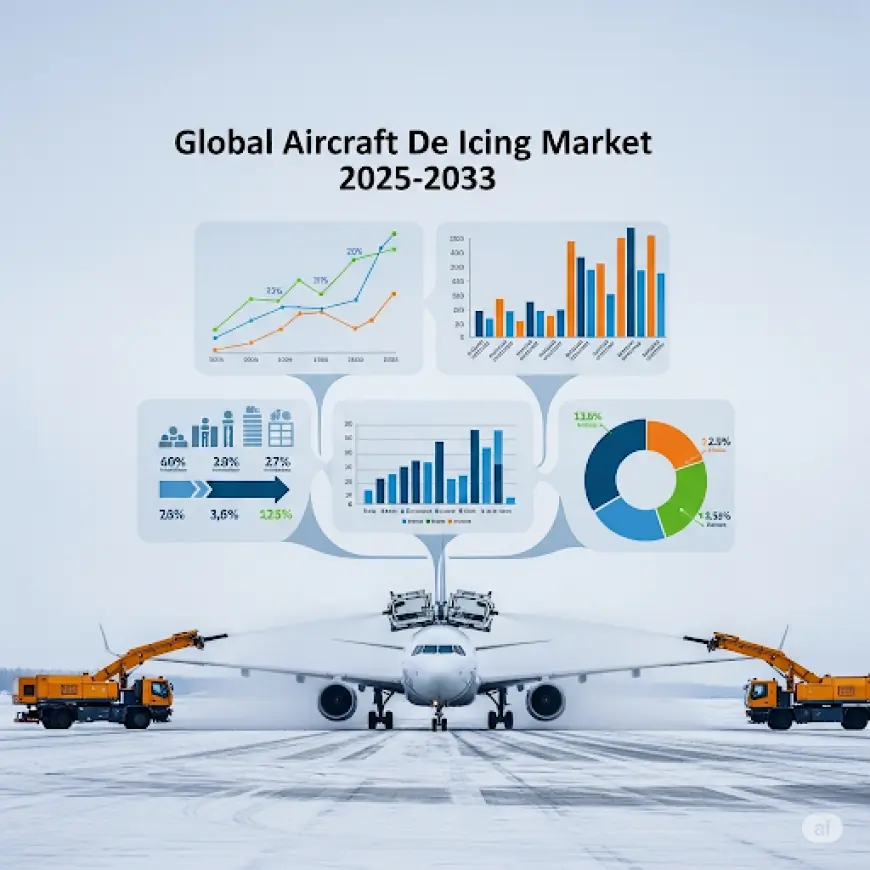Aircraft De Icing Market Outlook: How Tech & Eco Trends Are Changing the Game
The global aircraft de icing market reached USD 1.36 billion in 2024 and is projected to grow to USD 2.01 billion by 2033, with a CAGR of 4.23% .

Market Overview
The global aircraft de‑icing market reached USD 1.36 billion in 2024 and is projected to grow to USD 2.01 billion by 2033, with a CAGR of 4.23% . This expansion is driven by stricter safety regulations, rising winter aviation operations, and persistent investments in airport infrastructure. Rapid innovation in eco‑friendly fluids and automated de‑icing systems further supports this healthy outlook.
Study Assumption Years:
- BASE YEAR: 2024
- HISTORICAL YEAR: 2019–2024
- FORECAST YEAR: 2025–2033
Aircraft De‑Icing Market Key Takeaways
- Market Size & Growth: From USD 1.36 B in 2024 rising to USD 2.01 B by 2033 at a 4.23% CAGR.
- Regional Leader: North America dominates, thanks to extreme winters and extensive airline networks .
- Fluid Segment: Type I fluid leads in market share due to its rapid ice removal and cost-efficiency .
- Application Scope: Commercial aviation accounts for the largest share, marked by growing passenger and cargo flight volumes .
- Equipment Use: De‑icing trucks remain the preferred equipment due to their versatility and efficiency .
- Innovation Focus: Strong trend toward sustainable solutions—chemical-free systems and glycol recycling reducing environmental impact.
Market Growth Factors
1. Rising Air Traffic and Passenger Demand
One of the strongest factors fueling the growth of the aircraft de-icing market is the continuous increase in global air traffic. As more people travel for business, leisure, and trade, airlines are expanding their fleets and flight frequencies. This rising demand naturally increases the exposure of aircraft to harsh winter conditions, particularly in North America and Europe. Since ice accumulation on aircraft wings or engines can severely compromise safety, airlines are compelled to invest in reliable de-icing systems. Additionally, the expansion of international routes to colder destinations means a broader need for de-icing services. This combination of growing passenger demand and the critical importance of flight safety ensures a steady and rising need for advanced de-icing technologies, making this sector an attractive opportunity for stakeholders and investors.
2. Expansion of Airport Infrastructure in Cold Region
Airports in cold-weather regions are expanding their infrastructure to handle the growing number of flights and passengers. This includes investments in modern de-icing pads, centralized de-icing facilities, and advanced fluid storage systems. Countries like Canada, Russia, Norway, and northern parts of the U.S. are especially focused on strengthening their winter operation capabilities. As airports modernize, they seek more efficient de-icing technologies that reduce turnaround times while minimizing fluid wastage. These infrastructure upgrades provide an excellent growth pathway for de-icing equipment manufacturers and service providers. With governments and private operators prioritizing passenger safety and on-time departures, this trend highlights why the market is becoming increasingly critical for both short-term operations and long-term aviation planning.
3. Environmental Sustainability and Green Initiatives
Environmental concerns are pushing the aircraft de-icing industry to adopt eco-friendly practices. Glycol-based de-icing fluids, though effective, can pose environmental hazards if not properly managed. Governments and aviation authorities are enforcing stricter guidelines on fluid usage and disposal. This has opened opportunities for developing biodegradable fluids, closed-loop recycling systems, and energy-efficient de-icing technologies. Airlines and airports are increasingly looking for solutions that not only meet safety regulations but also align with their sustainability goals. This green shift not only enhances brand reputation but also reduces long-term costs associated with environmental compliance. As eco-friendly practices become a global standard, manufacturers offering innovative, sustainable de-icing solutions are well-positioned to capture a significant share of this evolving market.
Request for a sample copy of this report: https://www.imarcgroup.com/aircraft-de-icing-market/requestsample
Market Segmentation
Breakup by Fluid Type:
- Type I
- Type II
- Type III
- Type IV
Breakup by Application:
- Military
- Commercial
Breakup by Equipment:
- De‑Icing Trucks
- Sweepers
- Others
Breakup by Region:
• North America (United States, Canada)
• Asia Pacific (China, Japan, India, South Korea, Australia, Indonesia, Others)
• Europe (Germany, France, United Kingdom, Italy, Spain, Russia, Others)
• Latin America (Brazil, Mexico, Others)
• Middle East and Africa
Regional Insights
North America dominates the aircraft de‑icing market, largely due to its extensive airline network and harsh winter climate . Major international airports in the U.S. and Canada have robust de‑icing infrastructure and strict safety regulations. Investments in advanced technologies, such as heated strip systems and electric de‑icing vehicles, further strengthen the region’s leadership and support continued market expansion.
Recent Developments & News
Recent innovations in the aircraft de‑icing space show a strong shift toward eco-innovation and operational efficiency. In December 2023, Air Canada piloted Boston-based De‑Ice™’s electric current technology for A320s—reducing dependencies on glycol and cutting winter departure delays . In September 2023, Vilnius Airport launched the Baltics’ first glycol wastewater treatment plant, a €2.9 million initiative supported by the EU—underscoring increased regulatory and environmental momentum . Additionally, in early 2023, General Atomic Technologies-ASI validated cold-weather operations for the MQ‑9B SkyGuardian drone, emphasizing improved exchangeability of de‑icing techniques for military aviation .
Key Players
- B/E Aerospace Inc. (Rockwell Collins Inc.)
- BASF SE
- Clariant AG
- General Atomic Technologies
- Global Ground Support LLC (Air T Inc.)
- JBT Corporation (FMC Technologies)
- Kilfrost Ltd.
- The Dow Chemical Company
- Tronair Inc.
- UTC Aerospace Systems (Collins Aerospace)
- Vestergaard Company A/S
Ask Analyst for Customization: https://www.imarcgroup.com/request?type=report&id=2409&flag=C
If you require any specific information that is not covered currently within the scope of the report, we will provide the same as a part of the customization.
About Us:
IMARC Group is a global management consulting firm that helps the world’s most ambitious changemakers to create a lasting impact. The company provides a comprehensive suite of market entry and expansion services. IMARC offerings include a thorough market assessment, feasibility studies, company incorporation assistance, factory setup support, regulatory approvals and licensing navigation, branding, marketing and sales strategies, competitive landscape, and benchmarking analyses, pricing and cost research, and procurement research.
Contact Us:
IMARC Group
134 N 4th St. Brooklyn, NY 11249, USA
Email: [email protected]
Tel No: (+1-201971-6302)
What's Your Reaction?
 Like
0
Like
0
 Dislike
0
Dislike
0
 Love
0
Love
0
 Funny
0
Funny
0
 Angry
0
Angry
0
 Sad
0
Sad
0
 Wow
0
Wow
0

















































